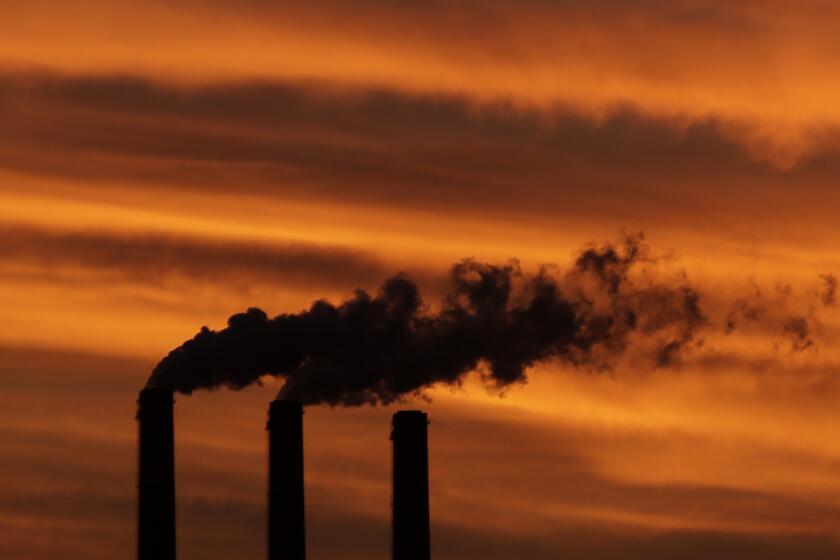How California will fight Supreme Court’s limits on EPA climate enforcement

- Share via
Many public officials and environmental advocates in California were dismayed by Thursday’s Supreme Court decision to limit federal authority on greenhouse gases from power plants, citing a collective blow to the monumental challenge of tackling global warming.
But experts say it’s not likely to unravel California’s ambitious climate goals to eliminate its carbon footprint by 2045. Instead, it reemphasizes the importance of strong state policy, they said.
“Any time federal power to regulate climate change is constrained, state power gets more important,” Cara Horowitz, co-executive director of the Emmett Institute on Climate Change and the Environment at UCLA School of Law. “California has always been a leader in the fight against climate change, and I expect that will continue and become even more crucial. States have a lot of regulatory power that this Supreme Court’s ruling does not touch.”
Horowitz said states will continue to determine the amount of renewable energy to power the grid. Perhaps most importantly for California, where the single largest source of carbon emissions is from on-road transportation, states will also wield the power to regulate vehicle emissions.
Ruling in favor of coal-producing states, Supreme Court says Congress, not the EPA, has the authority to make decisions on fighting climate change.
“Before the ruling came out, there was some concern that the court’s decision could threaten California’s waiver under the Clean Air Act, which lets California restrict greenhouse gas emissions from cars,” Horowitz said. “Because this case does not constrain EPA’s authority to regulate greenhouse gases from motor vehicles, at least not directly, I think there’s good reason to think that California’s auto emissions standards for climate pollution survive. That’s a big centerpiece of California’s climate program.”
However, given the collective response needed to rein in heat-trapping gases into the atmosphere, many feared this decision might prompt uneven response across the country — inaction that could carry life-threatening consequences as a warmer climate creates conditions more suitable for natural disasters. In recent years, California has already witnessed record-setting heat, unprecedented wildfires and historic drought.
“The radical Supreme Court has weakened our country’s ability to prevent the climate crisis from becoming a catastrophe for our planet and everyone living on it,” said U.S. Rep. Nanette Diaz Barragán (D-San Pedro). “By sharply limiting the EPA’s authority to regulate greenhouse gas emissions from power plants, Americans will suffer from extreme weather events such as droughts, heat waves, and storms. Rising temperatures and a delayed transition to cleaner sources of energy will threaten public health and reduce quality of life from increased air pollution. This burden will fall hardest on low-income communities and communities of color.”
Recurring drought and rising temperatures have already begun to alter the landscape of California and the American Southwest, researchers warn.
California Atty. Gen. Rob Bonta described the Supreme Court decision as “misguided and gravely disappointing.” He acknowledged it would have “dangerous consequences” at a time when the global climate leaders are calling for drastic reductions to stave off the worst impacts of climate change.
“We are running out of time in the fight against climate change, and we need all levels of government working together to take action before it’s too late,” Bonta said. “In California, we have strong programs in place to address climate change, and we will not go backwards. We will continue to use all the tools we have to reduce emissions, fight climate change, and protect public health. That includes pushing for stronger environmental regulations at the federal level. With the future of our planet at stake, our commitment to tackling the climate crisis cannot waver.”
California officials have made reducing greenhouse gases a top priority, citing billions of dollars in potential health benefits and averted economic damages.
Since greenhouse gas emissions peaked in California in 2004, the California Air Resources Board has ambitiously charted a course to carbon neutrality by no later than 2045. State law requires California to cut emissions to 40% below 1990 levels by 2030.
The board’s staff-recommended proposal, unveiled earlier this year, calls for a tremendous ramping up of clean technology by 2045, including: a thirtyfold increase in zero-emission vehicles, four times the amount of power generation from wind and solar energy, and a 91% drop in petroleum demand.
In 2019, 40% of the state’s greenhouse gas emissions came from on-road transportation. Industrial operations were the second-largest source of emissions, with 21%.
More to Read
Toward a more sustainable California
Get Boiling Point, our newsletter exploring climate change, energy and the environment, and become part of the conversation — and the solution.
You may occasionally receive promotional content from the Los Angeles Times.











